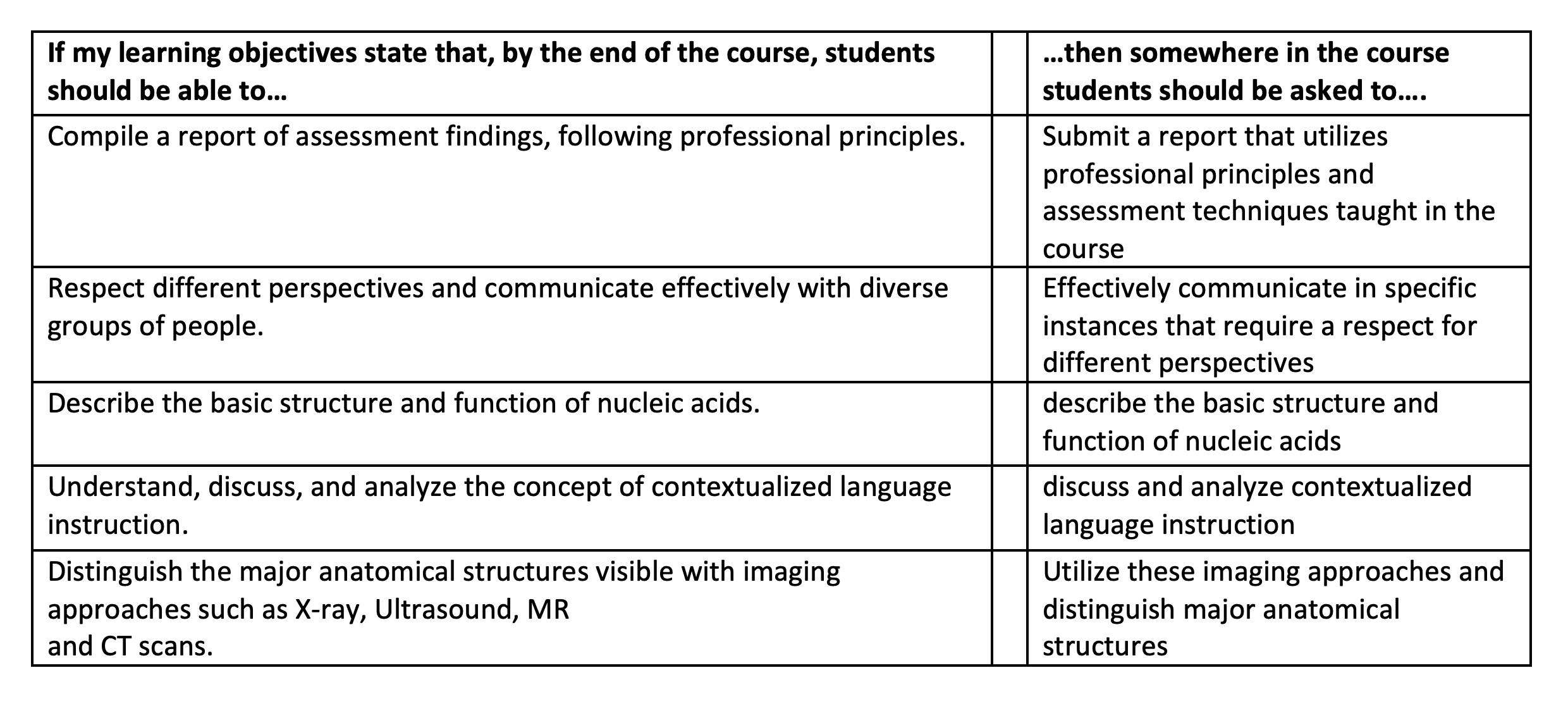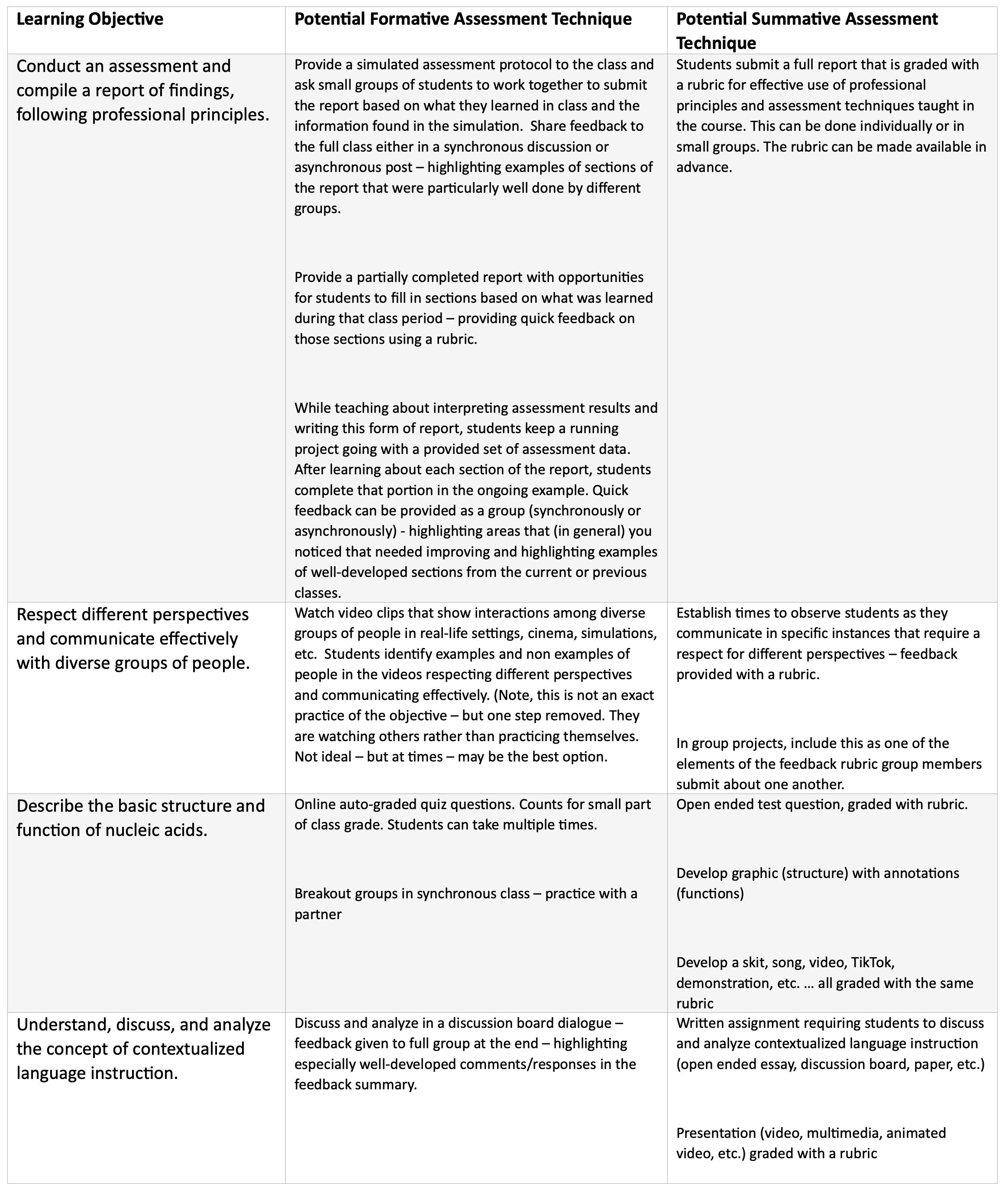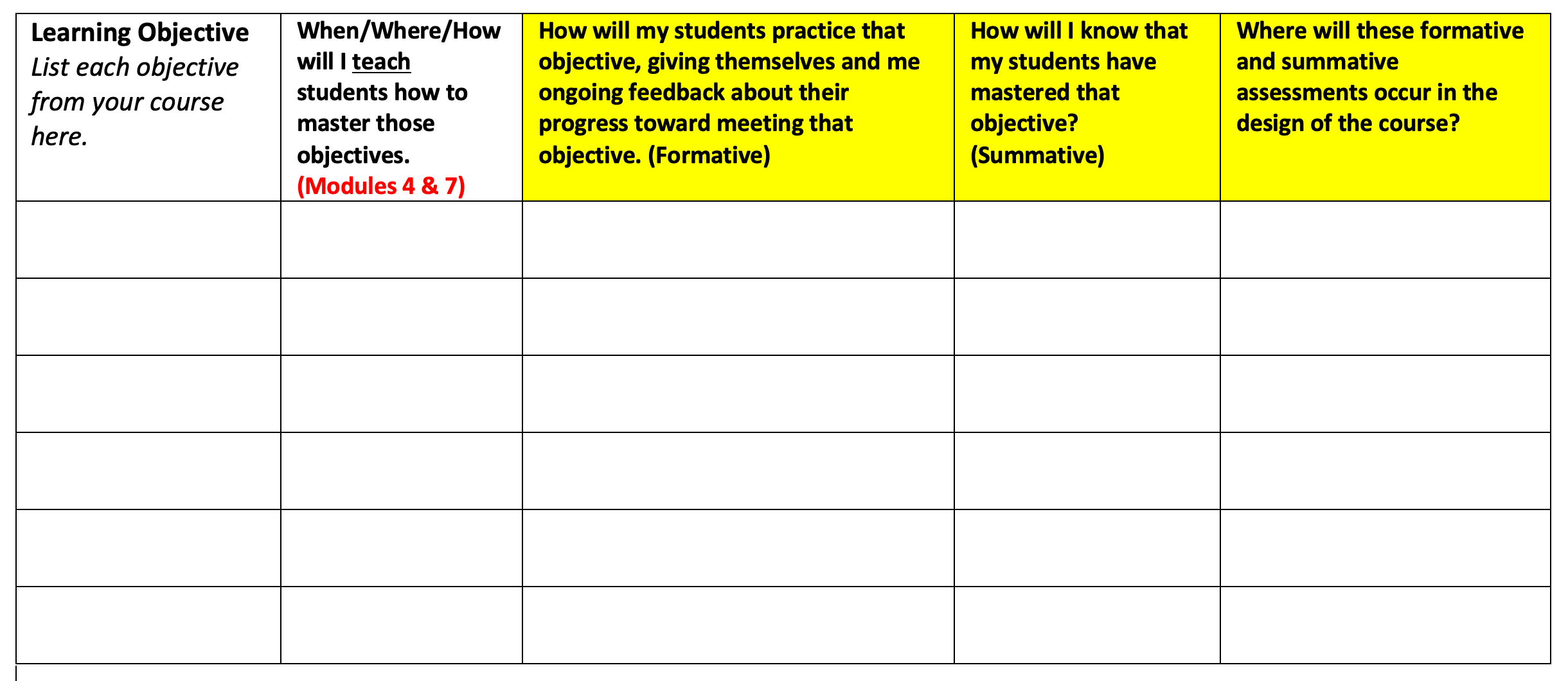3. Explore assessment options and establish your assessment strategy
![]()
“Measure what you value instead of valuing only what you can measure.” – Andy Hargreaves
Now that you have a clear idea of the learning objectives that will guide your course, you know what you want your students to be able to master by the conclusion of the course. It’s time to explore assessment options and establish your assessment strategy.
Objectives
By the end of this lesson, you will:
- Identify assessment strategies for each of your learning objectives for the course.
- Build a blend of formative or summative assessment measures that align with your learning objectives.
- Ensure assessments will be varied and valid, reducing unnecessary barriers for students to show what they have learned in your course.
- Identify where, within the course, you will embed each assessment.

 Instruction
Instruction

Right now you are just planning.
Don’t try to spend time actually building any of the assessment tools you come up with during this module. Your plans may evolve as you work through the next couple of modules, so hold off until you know you will be using your time efficiently. At the end of this module, you will have a roadmap for your assessment plan, but you may want to hold off on developing the actual measurement tools and resources.
The learning objectives for your course should completely drive the assessment strategies. Try to blend both formative and summative assessment opportunities for each objective into the design of a course, ensure the assessments are free of unnecessary barriers, and take into consideration a wide range of learner profiles.
Aligning Assessment Strategies with Learning Objectives
In Module 2 you ensured that your learning objectives were measurable – so now determine how you will measure whether students have mastered the learning objectives.
Once you determine your learning objectives, it’s so easy to dive right into building a PowerPoint file, composing your course notes, or planning a great hands-on activity. While, for many, that’s the “fun stuff” or the place where we often feel most confident. But first, pause.

Resist that temptation for now.
Before you even start thinking about how you will convey content related to the course objectives, instead focus on how you will know if you and the students have accomplished those learning objectives. What will that look like?
There are lots of ways to teach content and skills (modules 4 – 7), and Academic Freedom provides faculty with a wide range of choices for how to facilitate learning. It is so easy for us to get caught up in the activities we want to facilitate, materials we need to prepare, etc. that we creep away from the actual learning objectives by the time we get to developing our course assessments. Not only does this potentially risk the validity of the assessments, it also can build in unintentional barriers for students to show you what they’ve learned.
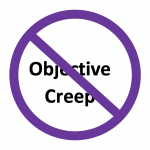
The students aren’t the only ones who benefit from avoiding objective creep. Have you ever found yourself spending a lot of time and energy trying to wade through, provide feedback on, and trying to assess learning a huge stack of papers students have written, when the instructional objective (and expectations for student learning) had nothing to do with writing a paper? Focusing our energy on what we really want to know (did they learn what we wanted them to learn) rather than the activity or task (paper, essay, presentation, exam) might reduce unnecessary frustration for the student and save us time too.
Formative and Summative Assessments
Consider building two types of assessments into the course for each objective: formative and summative. This may not always be appropriate or possible, but when it is, build in an opportunity for students to practice with guidance and quick feedback (formative) and an opportunity for students to demonstrate their learning to you (summative).

Formative Assessments
Formative assessments provide students with opportunities to practice and/or demonstrate early learning for a lesson, unit, or course objective. The intent of the assessment is to give students early feedback about where they can feel confident about their learning and where they may need to spend more time, study, practice, etc. Formative assessments also give the instructor a quick and general understanding of where your students are in relation to mastering that particular objective. They are excellent tools for guiding your next steps with instruction (e.g. re-teach a concept to the entire class, offer a review session for a handful of students who need additional support, or reach out to one student who struggles with the material).
“Assessment is today’s means of modifying tomorrow’s instruction.” Carol Ann Tomlinson
There are many different ways to build formative assessment into your course design, but generally, formative assessments should be:
- Relatively Quick: These are often very brief – both for the students to complete and for you to respond. They are often embedded seamlessly into class discussions and activities.
- Opportunities for meaningful feedback: What will make the feedback “meaningful” will depend on the learning objective. That said, if you are not able to turn feedback around to students quickly it may be useless to guide their decisions about how to improve or your decisions about next instructional steps.
- Low risk/low stakes: Because formative assessments are simply designed to provide ongoing feedback, inflating the stakes unnecessarily may actually increase anxiety and limit learning rather than foster it. Some formative assessment measures can certainly be graded – and often are. You will just want to be sure you are not inadvertently raising the stakes if there is no real need to do so.
Examples of approaches to formative assessment could include:
- Drafts of writing assignments….or sections of a larger writing assignment submitted along the way
- Think-pair-share activity in a synchronous class
- Response cards/clickers/polls
- Quiz – maybe one that is auto-graded…and that students can take multiple times
- In-class group activity in synchronous class meeting
- Self-checks…. may be used by students along the way to build a study guide for the exam
- Discussion forums
Basically, formative assessments help you and your students know what needs to be done prior to the summative assessments.
Summative Assessments
Summative assessments are used to gauge mastery of a particular learning objective. They may come at the end of the course or at any time during the term but should align exactly with the course learning objectives. Examples of summative assessments might include tests, presentations, projects, portfolios, written work with a rubric.
You generally have a good bit of flexibility when designing your summative assessment strategies. Basically, pick a form of assessment that will best measure and match the level of your learning objective (e.g. knowledge, applied, evaluative)

Infographic From : https://www.bookwidgets.com/blog/2017/04/the-differences-between-formative-and-summative-assessment-infographic .<br />
For assistance with this infographic, please contact the disabilities service center.
From our Earlier Examples:
For your Course: Download and complete columns 3 and 4 the Formative and Summative Assessment Chart
Multiple Means of Assessment
Not all students learn the same way, and not all students express their learning best in the same ways. In the Universal Design for Learning (UDL) framework, the principle of Multiple Means of Action and Expression, emphasizes the need to provide different ways for students to show you what they have learned.
For some students, this is helpful.
For others, this is critical.
For example:
A student with dyslexia may be able to decode text for a multiple-choice exam, but it might be mentally exhausting to do so. For a student whose disability impacts the task of reading, every written test, regardless of the content, becomes a reading test. The task of tracking text and holding written options in mind while trying to select the correct one can drain even more working memory – leaving little energy to focus on the content and higher-order skills you may really want to assess. If all or most of a course grade is based on multiple-choice tests, are you really getting a complete picture of whether the student learned your material, or might you be testing something entirely different?
Imagine taking a test if the experience of reading felt like this:http://geon.github.io/programming/2016/03/03/dsxyliea.
Even if you were very well prepared, how would you do on the test?
…
For a student who experiences test anxiety, processing speed challenges, or is an English language learner, a timed test that is the correct level of challenging for some students might instead feel like a high-speed race.
…
For a student who has dysgraphia and challenges with spelling, an in-class essay can be a nightmare. Regardless of how well they know the content or how eloquent their ideas are, the writing task simply might not show it. They may spend the session making choices between using words that express their understanding or words they are able to spell. Handing in a paper full of misspellings is embarrassing, and the other choice may not enable them to fully convey their learning.
Fortunately, for students who have identified disabilities, the Disability Support Services Office can work with them to request accommodations to remove some of these barriers. Encourage your students to seek and use those supports when applicable.
Unfortunately, an estimated 75% of college students who would be eligible for disability-related accommodations (nationally) do not self-identify with the disability support office, and many more students have varied learning profiles, but do not have a disability diagnosis.
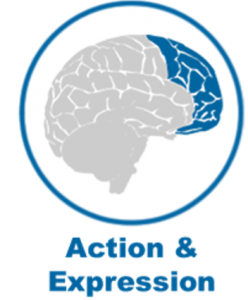
Any assessment comes with potential barriers and strengths for different students, simply due to the format being used. The idea is to use UDL as a lens through which you would try to notice the potential strengths and limitations of different assessment formats and incorporate a mix into your course design.
The principle of Multiple Means of Action and Expression can help, by encouraging us to think about adding choice from the beginning. By designing an assessment system that lets students show you what they’ve learned in different ways you can keep standards high and keep the challenge where it should be for everyone – in mastering the course goals. Think of adding variety in a couple of different ways:
At a minimum try to ensure that throughout the course varied forms of assessment are used.
When possible, integrate multiple ways of assessing the same objective into the course.
- At a minimum try to ensure that throughout the course varied forms of assessment are used.
- When possible, integrate multiple ways of assessing the same objective into the course.
Sometimes, you will even be able to incorporate choices within a single assessment.
 Resources
Resources
General
- Tips from Kansas State University for developing online assessments
- This short (3:52) video might spark some ideas about student assessment and peer assessment
Rubrics
- Developing a Grading Rubric – (Developed by Centre for Teaching and Learning at the University of Alberta, 8:29). This provides guidelines for developing three basic kinds of rubrics.
Proctoring
ECU Supported Assessment Tools
In general, most traditional assessments will be supported with Canvas, ECU’s official learning management system.
Canvas Assignments
Canvas Assignments include Quizzes, graded Discussions, and online submissions. Assignments can be assigned to everyone in your course, differentiated by section, or assigned to individual students. All assignment types have the option to attach a rubric or align to an outcome.
Canvas Quizzes
Canvas Quizzes is an extremely flexible assessment tool that allows for multiple types of questions and a large variety of answer responses. You have the ability to leave answer feedback on both correct answers and distractors. Question types include:
-
- Multiple Choice & True/False
- Fill-in-the-Blank & Fill-in-Multiple-Blanks
- Multiple Answers & Multiple Drop-down (can be used for Likert scale)
- Matching
- Numerical Answer
- Formula based auto-generated math questions (simple formula and single variable)
- Essay
- File Upload
Graded Discussions
Discussions can be graded or non-graded and allow for interactive communication in your class. Both instructors and students can start and contribute to discussion topics. For long discussions, use threaded discussions for different levels of nesting, and for short interactions use the default focused layout.
Video Quizzes – Canvas Studio
Canvas studio allows you to place multiple-choice questions directly over a video for either summative or formative assessment. As with Canvas Quizzes, you have the option to leave feedback to help your students learn more efficiently. In addition to the pop-up quizzes, Canvas Studio allows for students and instructors to comment on the video, allowing for an ungraded asynchronous conversation.
Proctoring
If you have a large-scale high-stakes test, ECU offers proctoring.
 Try it
Try it
- Download and complete the Formative and Summative Assessment Chart
Now, start mapping out your assessment strategy by filling in the three highlighted columns in the chart below. Begin to identify where, within the course, you will embed each assessment. These are just your starting ideas. They may evolve as you design the rest of the course.
